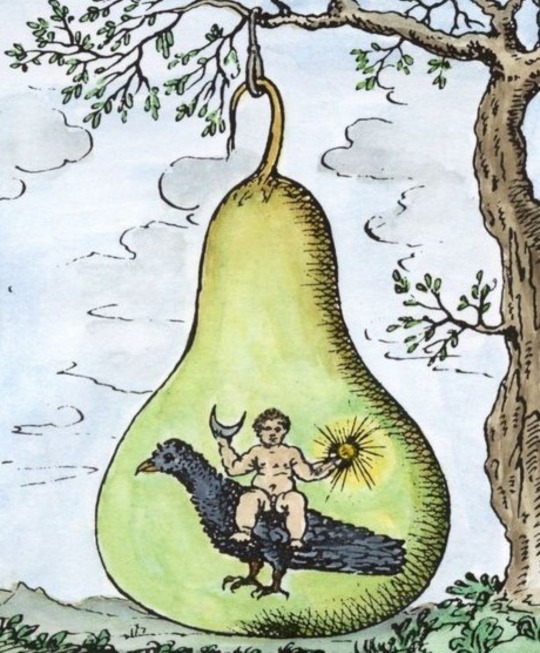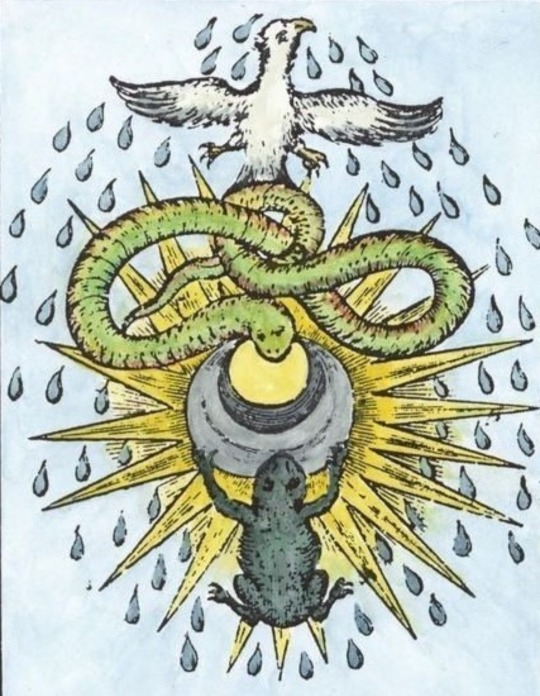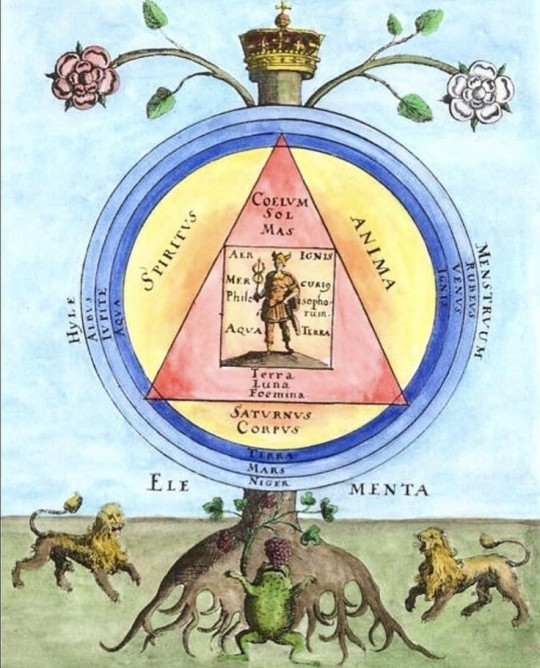#alchemy and science
Explore tagged Tumblr posts
Text
Alchemy to Chemistry: The Evolution of Scientific Thought
Alchemy. The word alone conjures images of cloaked mystics, bubbling flasks, and mysterious symbols scrawled in dusty old books. For centuries, alchemy was a blend of philosophy, science, mysticism, and art—an ambitious pursuit to understand the universe by transforming matter and, ultimately, the self. Often dismissed today as pseudoscience or proto-chemistry, alchemy was, in fact, a critical…
#alchemical symbolism#alchemy and modern chemistry#alchemy and science#alchemy in literature#alchemy vs chemistry#ancient science#Carl Jung alchemy psychology#history of alchemy#Isaac Newton alchemy#Jabir ibn Hayyan alchemy#Johannesburg blogger community#Johannesburg influencers to follow#medieval alchemists#Paracelsus medicine#philosopher’s stone#scientific revolution origins#Shaun Zietsman influencer#Shaun Zietsman South African blogger#South African Content Creators#South African lifestyle blogger#South African social media influencer#spiritual alchemy#The Something Guy blog#The Something Guy Johannesburg influencer#transmutation alchemy
0 notes
Text

"The universe is written in the language of mathematics, and its characters are triangles, circles, and other geometric figures"
~ Galileo Galilei, Il Saggiatore
#galileo galilei#sacred geometry#consciousness#light#energy#magic#quotes#ancient#enlightenment#age of aquarius#golden age#godhood#mathematics#geometry#science#simulated reality#simulated universe#simulation theory#holographic universe#alchemy#magical#ascension#esoteric#occult
2K notes
·
View notes
Text

Illustration created for my upcoming new book, Ergo Cosmos!
"The first of the alchemists was he who set fire to the pyre upon which the Veiled Lady burned. To atone for such a sin, all those who are privy to the Highest Secrets swear to use the hand of will exclusively to restrain evil, and the hand of intuition only to perform good deeds. From this sorrowful figure derives the name of this sacred commitment, which is commonly known as the Oath of Minos."
#fantasy#artists on tumblr#fantasy illustration#medieval fantasy#magic#science fiction#ttrpg#indie ttrpg#artbook#ink drawing#scifiart#retro aesthetic#retro scifi#creature#concept art#landscape#xenobiology#speculative biology#worldbuilding#bestiary#mythical creatures#alchemy
790 notes
·
View notes
Text

Okay hear me out, you can’t tell me Ed came up with the idea of transmuting a flying fist at least once.
#fullmetal alchemist#fma fanart#roy mustang#edward elric#I came up with this during science class ironically enough#like a hand with alchemy circles on top that make it connect back to him#IMAGINE HOW COOL IT WOULD BE IF HE USED THEM DURING FIGHTS#my art
288 notes
·
View notes
Text

Theodore de Bry - 1578
#esoteric#old science#astronomy#astrology#witchy#etching#engraving#hermetic#alchemy#arcane#mystic#old art#gothic#illustration#occult#esoteric art#esoteric witch#artwork#witchy things#witchcraft#magick#black and white#monotone#mysticism#theology#occult aesthetic#occult engraving#esoteric illustration#occult illustration#old illustration
174 notes
·
View notes
Text
Ancient Alchemy

Alchemy is one of the oldest mystical and proto-scientific traditions, blending philosophy, chemistry, spirituality, and metaphysics. It was practiced across multiple civilizations, including Egypt, Greece, China, India, and the Islamic world, each contributing to its development.
⚗Origins and Evolution of Alchemy
Ancient Egypt & Hermetic Alchemy (c. 2000 BCE - 300 BCE)
• Egyptian priests practiced early alchemical processes, such as metal purification and embalming.
• Thoth, later known as Hermes Trismegistus, was considered the patron of alchemy, giving rise to the Hermetic Tradition.
• The Emerald Tablet, attributed to Hermes, introduced the concept of ���As above, so below,” suggesting the microcosm reflects the macrocosm.
Greek and Hellenistic Alchemy (c. 300 BCE - 400 CE)
• Greek philosophers like Empedocles and Plato theorized about the four classical elements (earth, water, air, and fire) as the building blocks of reality.
• The idea of the Quintessence (Aether) emerged as a mystical fifth element.
• Alchemy merged with Gnosticism and early Christian mysticism.
Indian and Chinese Alchemy (c. 400 BCE - 1200 CE)
• Indian Alchemy (Rasasastra) focused on immortality and transforming metals into gold, with mercury playing a key role.
• Chinese Alchemy (Neidan & Waidan) aimed at achieving the Elixir of Immortality, focusing on both external substances (Waidan) and internal spiritual practices (Neidan).
• Daoist alchemists sought balance through the Yin-Yang and the Five Elements.

Islamic and Medieval European Alchemy (c. 700 CE - 1600 CE)
• The Islamic world preserved and expanded alchemical knowledge, with figures like Jabir ibn Hayyan (Geber), who systematized laboratory techniques.
• Alchemy entered medieval Europe through translations, inspiring figures such as Albertus Magnus, Roger Bacon, and Paracelsus.
• The quest for the Philosopher’s Stone—a mythical substance granting immortality and transmuting base metals into gold—became central.
Renaissance and Early Modern Alchemy (c. 1500 - 1700 CE)
• The fusion of alchemy and early chemistry occurred through figures like Isaac Newton and Robert Boyle.
• Paracelsus emphasized spagyric alchemy, focusing on the medicinal applications of alchemy rather than purely transmutational goals.
• The rise of the Rosicrucians and Freemasons kept alchemical philosophy alive in esoteric circles.
⚗Core Principles of Alchemy
The Three Alchemical Principles (Tria Prima – Paracelsus)
Alchemy posits that all matter consists of three essential principles:
• Sulfur (Soul) – Represents spirit, transformation, and the volatile aspects of existence.
• Mercury (Mind) – Symbolizes fluidity, adaptability, and the connection between spirit and body.
• Salt (Body) – Embodies physical form and stability.

⚗The Four Classical Elements
Alchemy works with the foundational elements of Earth, Water, Air, and Fire, believing these are essential to transmutation and spiritual purification.
The Magnum Opus (Great Work)
The process of transmutation was divided into four symbolic stages:
• Nigredo (Blackening) – Death, dissolution, and breaking down impurities.
• Albedo (Whitening) – Purification and enlightenment.
• Citrinitas (Yellowing) – Awakening and the infusion of divine light.
• Rubedo (Reddening) – Completion, the birth of the perfected being, or the Philosopher’s Stone.
⚗Applications of Alchemy
Physical & Material Alchemy (Transmutation & Chemistry)
• Attempting to turn lead into gold symbolized the refinement of base matter into perfection.
• Alchemists developed early chemical processes, including distillation, sublimation, and crystallization, laying the groundwork for modern chemistry.
• Gunpowder, acids, and medicinal compounds were discovered through alchemical experiments.
Spiritual & Mystical Alchemy
• Many saw alchemy as a metaphor for spiritual enlightenment—transforming the “lead” of the mundane self into the “gold” of the divine self.
• The Philosopher’s Stone was also symbolic of self-realization and immortality.
• Theurgy and Hermetic practices integrated alchemy with ritual magick to invoke higher states of consciousness.

Medicine & Healing (Alchemical Medicine – Spagyrics)
• Paracelsus introduced the idea that diseases could be cured by extracting the essence of plants and minerals.
• Early homeopathy and herbal medicine developed from these alchemical principles.
• Some alchemists sought longevity elixirs, believed to extend life or even grant immortality.
Psychological Alchemy (Carl Jung’s Interpretation)
• Carl Jung saw alchemy as a metaphor for psychological individuation, where the Magnum Opus represented self-integration.
• The shadow (Nigredo), anima/animus (Albedo), and self-realization (Rubedo) were psychological processes paralleling alchemical transformation.
Occult and Modern Esoteric Alchemy
• Alchemical concepts remain central in Hermeticism, Thelema, Rosicrucianism, and Freemasonry.
• The idea of internal alchemy is found in modern spiritual traditions, focusing on energy work, ascension, and self-deification.
⚗Legacy of Alchemy in the Modern World
• Chemistry & Pharmacology: Many laboratory techniques originated from alchemical practices.
• Spiritual Development: The concept of personal transformation remains a key theme in occult traditions.
• Symbolism & Psychology: Alchemy’s symbols and processes influence Jungian psychology and self-improvement methodologies.
Alchemy is far more than just the pursuit of gold—it is a science of transformation at all levels: material, spiritual, and psychological. From its ancient roots in Egypt and China to its esoteric revival in modern mysticism, alchemy continues to inspire those seeking wisdom, power, and enlightenment.

#alchemy#Alchemist#Ancient alchemy#philosopher's stone#transmutation#transformation#magic circle#herbs#chemistry#science#history#esoteric#occult#eclectic witch#eclectic#pagan#magick#witch#witchcraft#witchblr#witch community#satanic witch#lefthandpath#chaos witch#chemicals#elements#as above so below#thoth#hermes#dark
184 notes
·
View notes
Text
did not have "actual fucking alchemy" on my 2025 bingo card
100 notes
·
View notes
Text

The Alchemist by David Teniers the Younger
#david teniers the younger#art#flemish#alchemist#alchemical#alchemy#mysticism#science#magic#knowledge#europe#european#history#book#books#gold#bowl#kettles#stoves#glassware
264 notes
·
View notes
Text
Just Wormwood hanging out with a couple machines :]

So I thought this would be a cute idea, since some of Wormwood's quotes regarding machines and equipment are very humanizing, and that might partially be because of WX-78's influence and partially because he's always been doing this sort of thing with various statues and figures.
#dst#don't starve#don't starve together#dst wormwood#ds wormwood#dst fanart#dst jimmy#digital art#my art#science machine#and wobot#and flingo + alchemy engine#because why not#:]#might do a second complementary piece 😉
232 notes
·
View notes
Note
Who was Paracelsus?
Paracelsus was the screen name of Philippus Bombastus Romastus Fantastus Supercalafragalisticexpialadastus von South-Stuttgart-Next-To-The-University-Cafeteria-With-The-Zig-Zag-Roof. His name Paracelsus literally means "Better than Celsus." We do not know who Celsus may have been, but the name is likely a reference to St. Jerome Para-Ezra of Baton Rouge, who was known in his time to have been far better than Ezra.
Paracelsus invented many of the medical techniques used from medieval times to the modern medical revolution, including bleeding, leeching, exsanguination, draining blood from the patient, and ultra-hemorrhagic-cleansing. He also coined the phrase "Only the dose determines the poison," as well as its corollary, "You can eat anything, just some things you can only eat once," and the less impressive but better known, "He who smelt it, dealt it." This was all considered an advancement over the old theory of bodily humors, which is why Paracelsus's friends all said he was a humorless bastard, or so he kept claiming.
Paracelsus was married in a Rosicrucian ceremony based on the Chemical Wedding of Christian Rosenkreutz, which was of course preceded by Chemical Engagement and a Chemical Romance involving a black parade, the theatrical faking of several deaths, and a great deal of sodium (a mass scientifically abbreviated as Na Na Na (Na Na Na Na Na Na Na Na Na). To whom he was married is a matter of much debate, with potential spouses speculated to include Shakespeare, Queen Elizabeth I, Queen Elizabeth II, Martin Luther, Galileo, Ivan the Terrible, Thomas Hobbes, John Calvin, Catherine Di Medici, the Popes Alexander V-VIII, or possibly all at once.
Paracelsus died in the 1540s after suffering a minor splinter which he treated with his own experimental technique known as "setting the patient on fire and stabbing him with a fork in his balls until he barfs then laughing at him." He was then cremated with his urn displayed at the University of Hohenheim for several centuries, until he was accidentally misplaced during an American tour and is presumed to have been used as ash in some Humboldt Fog Cheese, which was considered an affront to his Swiss heritage.
Also he apparently invented Zinc. Good job.
433 notes
·
View notes
Text

What Trauma Actually Does To The Brain: An Educational + Deep Dive Into the Nuerobiology of Survival
When people say trauma “rewires your brain,” it’s not metaphor. It’s neurology.
Understanding trauma’s impact on the brain helps to demystify our reactions — and lift the weight of shame. Trauma survivors often ask, “Why am I like this?” The answer is: because your brain adapted perfectly to danger. Let’s break this down.
Chemically Speaking: What changes?
1.Cortisol & Adrenaline Override
Trauma floods your system with stress hormones, primarily cortisol and adrenaline.
This is useful short-term: it sharpens reflexes and numbs pain. But in chronic trauma? These chemicals get stuck on high.
🔸Result: Hypervigilance, anxiety, difficulty sleeping, poor digestion, high heart rate, emotional flooding.
2. Neurotransmitter Dysregulaion
Repeated trauma interferes with:
Serotonin (mood stability)
Dopamine (pleasure & motivation)
Norepinephrine (alertness)
Oxytocin (trust and bonding)
🔸Result: Depression, low energy, difficulty feeling joy, trouble connecting with others or yourself.
3. Histamine & Immune System Overreaction
Many trauma survivors experience mysterious allergies or sensitivities. That’s because trauma activates mast cells and increases histamine, which is meant to fight threats—but in trauma, the body starts treating life like one big emergency.
🔸Result: Skin flare-ups, food sensitivities, digestive issues, headaches, overeating.
Structurally Speaking: What gets rewired?
Amygdala (Fear Center)
The amygdala becomes overactive. It constantly scans for threat — even when you’re safe.
🔸You feel: Startled easily, overwhelmed by crowds, panicked by “nothing.”
Prefrontal Cortex (Logic & Decision-Making)
This part shrinks with chronic trauma exposure, making it harder to regulate emotion or make clear decisions.
🔸You feel: Scattered, impulsive, like your thoughts run too fast or not at all.
Hippocampus (Memory & Context)
This structure gets damaged by cortisol, shrinking over time.
You may struggle to remember things clearly—or feel hijacked by memory fragments or body sensations.
You feel: Disoriented, like past and present blur, or like your body “remembers” things you can’t explain.
You are not broken.
You’re adapted.
If you’ve:
Lost your appetite or have food aversions
Felt “frozen” when trying to make a simple decision
Reacted strongly to sound, smell, texture or light
Needed rigid routines just to feel okay
..your brain is doing exactly what it was trained to do.
Trauma isn’t just emotional pain. It’s a full-body reprogramming for survival.
The Good News: Neuroplasticity
The brain is not fixed. Healing is possible.
With:
Trauma-informed therapy (EMDR, somatic work, IFS)
Regulation practices (breath work, safe ritual, or co-regulation)
Nutrition and movement, when accessible
..your brain begins to rewire itself back toward safety.
Every time you listen to your needs, rest, hydrate, name your truth, or say no—you’re re-parenting your nervous system.
Instead of:
“Why am I like this?”
Try:
“What did I survive that made this necessary?”
Let this serve as both science and sacred permission.
To be soft. To be patient.
To be a body learning how to come home again.
#spiritualtrauma #scienceoftrauma
#trauma alchemy#trauma recovery#nervoussystemhealing#neurodivergent#neurodiversity#cptsd recovery#actually cptsd#somatichealing#somatic awareness#science#brain rewiring#emotional health#science of emotions#mental health education#mental health#mental illness#neuroplasticity#arfid#complex ptsd#complex trauma#healing journey#nervous system
56 notes
·
View notes
Text

Everything is sound.
#light#energy#consciousness#magic#ascension#sacred geometry#fibonacci sequence#fibonacci spiral#alchemy#science#calming sounds#esoteric#occult#age of aquarius#golden age#enlightenment#kundalini awakening
1K notes
·
View notes
Text



Alchemists - for my upcoming novel Ergo Cosmos.
"He who has ears to hear, let him hear."
What you Seek is Seeking You.
More in the comment section.
#fantasy#fantasy illustration#character design#retro scifi#character art#ink drawing#drawing#concept art#scifi illustration#scifi and fantasy#dark fantasy#science fantasy#alchemy#magick#renaissance#15th century#space opera#surreal#sigil magic
111 notes
·
View notes
Text

Transmutation II The second part to an already exisiting piece also expanding the collection of the albino werewolf pieces. This piece was long in the waiting phase. It was sketched alongside the other piece but always landed on the backburner somehow.

Okay quick update! Since posting this piece I've already got several messages of people asking me if the new piece will be available as well. I've decided to extend the tapestry form until Sun. 17th of November & adding the new piece to the selection!

#werewolf#werewolves#wolf#werewolf wednesday#werewolf transformation#transformation#wolf art#werewolf art#manuscript#medieval manuscript#alchemy#arcane#illuminated manuscript#moon#celestial#astronomy#skeleton#anatomy#anatomical diagramm#medieval science#medieval#fantasy#digitalart#medievalart#digital art#art#lunegrimmart#creature#lycanthrope#knotwork
166 notes
·
View notes
Text

“Phantasies” 1620
#alchemy#symbolism#hermetic#old art#vintage#old book#engraving#etching#esoteric illustration#illustration#occult#artwork#esoteric#gothic#monotone#monochrome#moody#dark#dark aesthetic#goth art#alchemical#spiritual#old science#vintage books#vintage art#witchy things#spiritual art#black and white#medieval#gothcore
135 notes
·
View notes
Text




Took the time to finish Rena's page to go alongside Lana's uvu
Through drawing all of this I had the realization that nowadays I struggle a lot more to draw Rena "quickly" - which is the complete opposite of how things were years and years ago when I first started developing her and Lana (back then it has soooo much trouble drawing Lana 'like in my head'...)
I think one of the reason for this is that I am now a lot more... specific about how I want Rena to look ? And getting her vibe right is. So. Fucking. Hard. x,) Hopefully it'll become easier again as I get used to drawing both of them more again...
(This art meme was made by shuuzaar !)
#rena#renaiel#renaïel#beary art#art meme#haircut meme#haircut art meme#symphonia#paracosm#zellk#oc#ocs#zellkabellk#guys I poured my WHOLE ASS into that top left drawing to make her look as hot as possible#she deserves it (for everything i put her through in her story...)#i love her red teeth.... they make her look so fucking weird it's perfect#idk if she can hide it when in human form actually like... to look more 'normal' for infiltration & shit#or maybe she has to use products (from alchemy/science) or magic to make them appear white
55 notes
·
View notes